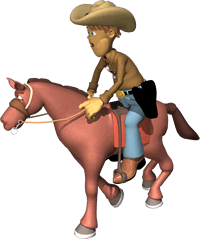Third Grade - Language Arts
Activities
Cowboy Bob Builds A Community
Financial and Economic Concepts: Federal, state, and local taxes Third Grade – Language Arts
Third Grade – Language Arts
3.SL.1: Engage effectively in a range of collaborative discussions (one-on-one, in groups, and teacher-led) with diverse partners on grade 3 topics and texts, building on others’ ideas and expressing their own clearly.
3SL.3: Ask and answer questions about information from a speaker, offering appropriate elaboration and detail.
3SL.6: Speak in complete sentences when appropriate to task and situation in order to provide requested detail or clarification.
 Time: 30 Minutes
Time: 30 Minutes
Materials: Optional – Computer with Internet, projector
Students will begin to rebuild the ghost town selecting buildings/services that they think a community needs in order to grow. They will tell why the buildings and services they suggest are necessary, and what each one will do for the people of the town. They will determine for each new business recommend, whether it produces a good or a service.
Students will determine which of these businesses or agencies are paid for by taxes and which ones depend on money spent by customers who pay for goods and services.
![]() Complete Lesson Plan (includes introduction, task, process, conclusion, assessment activity, and extension activity)
Complete Lesson Plan (includes introduction, task, process, conclusion, assessment activity, and extension activity)
Heather Learns About Earnings
Financial and Economic Concepts: Basic budgeting Third Grade – Language Arts
Third Grade – Language Arts
3 RIT.1: Ask and answer questions to demonstrate understanding of a text, referring explicitly to the text as the basis for the answers.
3 RIT.2: Determine the main idea of a text; recount the key details and explain how they support the main idea.
3 RFS.4: Read with sufficient accuracy and fluency to support comprehension.
 Time: 30 Minutes
Time: 30 Minutes
Materials: Computer with Internet, projector, Optional handout
Heather Learns About Earnings – This link provides an animated and interactive story about income. After reading the story to the class, discuss the following questions:
- What was Heather’s problem?
- How did she earn the money she needed?
- What else could Heather have done to earn the money she needed?
Tim's Turn to Learn
Financial and Economic Concepts: Basic budgeting Third Grade – Language Arts
Third Grade – Language Arts
3. RIT.1: Ask and answer questions to demonstrate understanding of a text, referring explicitly to the text as the basis for the answers.
3. RIT: 2: Determine the main idea of a text; recount the key details and explain how they support the main idea.
3. RFS.4: Read with suffieient accuracy and fluency to support comprehension.
3.SL.1: Engage effectively in a range of collaborative discussions (one-on-one, in groups, and teacher-led) with diverse partners on grade 3 topics and texts, building on others’ ideas and expressing their own clearly.
 Time: 45 Minutes
Time: 45 Minutes
Materials: Computer with Internet, projector, Handouts
Tim’s Turn to Learn – This link provides an animated and interactive story about what a budget is and the difference between wants and needs. After reading the story to the class, discuss the review questions. At the end of the give students the printable tracker for students to track the money they spend for the week. (Math: have students total their weekly spending).
![]() Review Questions (pdf)
Review Questions (pdf)
![]() Spending Tracker (pdf)
Spending Tracker (pdf)
Off to Interactive Island
Financial and Economic Concepts: Opportunity Cost and Tradeoffs and Decision Making Third Grade – Language Arts
Third Grade – Language Arts
3.RIT.1: Ask and answer questions to demonstrate understanding of a text, referring explicitly to the text as the basis for the answers.
3.RIT.2: Determine the main idea of a text; recount the key details and explain how they support the main idea.
3.RFS.4: Read with sufficient accuracy and fluency to support comprehension.
3.SL.1: Engage effectively in a range of collaborative discussions (one-on-one, in groups, and teacher-led) with diverse partners on grade 3 topics and texts, building on others’ ideas and expressing their own clearly.
3.SL.6: Speak in complete sentences when appropriate to task and situation in order to provide requested detail or clarification.

Time: 30 Minutes
Materials: Handouts
This activity provides a fun way to explore concept of economic decision making. In the lesson, students are given a limited number of “tokens” and asked to exchange those tokens for goods in preparation for pioneering in a new land. They are then asked to identify what they have left behind and give reasons for their choices. Finally, they are asked to identify the costs and benefits and the opportunity costs of their choices.
Have students choose between four toys. Ask them to write, draw a picture, or verbally explain their choice. Ask them to indicate the opportunity cost of that choice.
Arrange several treats on your desk. Be sure to provide a variety of inexpensive choices. Allow students to choose either one treat, a no homework day, or 10 extra minutes on the playground. Ask students to explain the cost of their choice and the benefits.
![]() Choices Activity Sheet (pdf)
Choices Activity Sheet (pdf)
![]() Choices Math Sheet (pdf)
Choices Math Sheet (pdf)
The Gift of Time
Financial and Economic Concepts: Charitable Giving Third Grade – Language Arts
Third Grade – Language Arts
3.W.4: With guidance and support from adults, produce writing in which the development and organization are appropriate to task and purpose.
3.W.5: With guidance and support from peers and adults, develop and strengthen writing as needed by planning, revising, and editing.
3.W.6: With guidance and support from adults, use technology to produce and publish writing (using keyboarding skills) as well as to interact and collaborate with others.
 Time: 30 Minutes
Time: 30 Minutes
Materials: Horton Hatches an Egg by Dr. Seuss, writing supplies
Students will become aware that there are many ways in which one can give a "gift." They will also learn that they can feel joyful about giving.
![]() Complete Lesson Plan (See Step 2)
Complete Lesson Plan (See Step 2)
Writing a Math Story
Financial and Economic Concepts: Basic budgeting Third Grade – Language Arts
Third Grade – Language Arts
Standard 8: Writing Students write daily to communicate effectively for a variety of purposes and audiences.
Objective 2: Compose a written draft.
 Time: 45 Minutes
Time: 45 Minutes
Materials: Writing supplies
After learning how to add and subtract decimals, the students will listen to Alexander Who Used to be Rich Last Sunday by Judith Viorst, then write their own story that involves adding and subtracting money. Students are required to show their math work.
- Students will listen to the teacher read Alexander Who Used to be Rich Last Sunday.
- Class will discuss the steps that happened in the story to cause Alexander to not be rich anymore.
- The students will write their own story either about themselves or a made up character that involves the addition and subtraction of money.
- Instructor will give them an example: I started with $200 that I got for my birthday. I wanted to buy this really cool CD so I did. It cost $15.95. That left me with $184.05. I had to babysit for my neighbor on Tuesday and I made $12. Now I have $196.05.
- When students are finished they must turn in their story and show their math work for each step of the problem.
The students will be assessed on the accuracy of the math work in the story.


